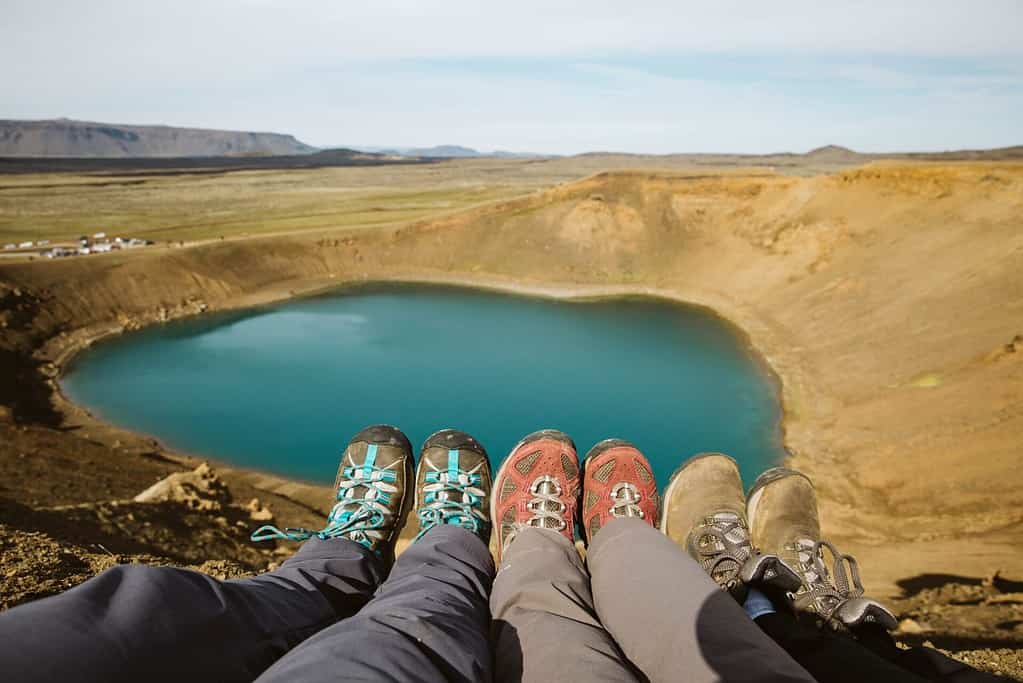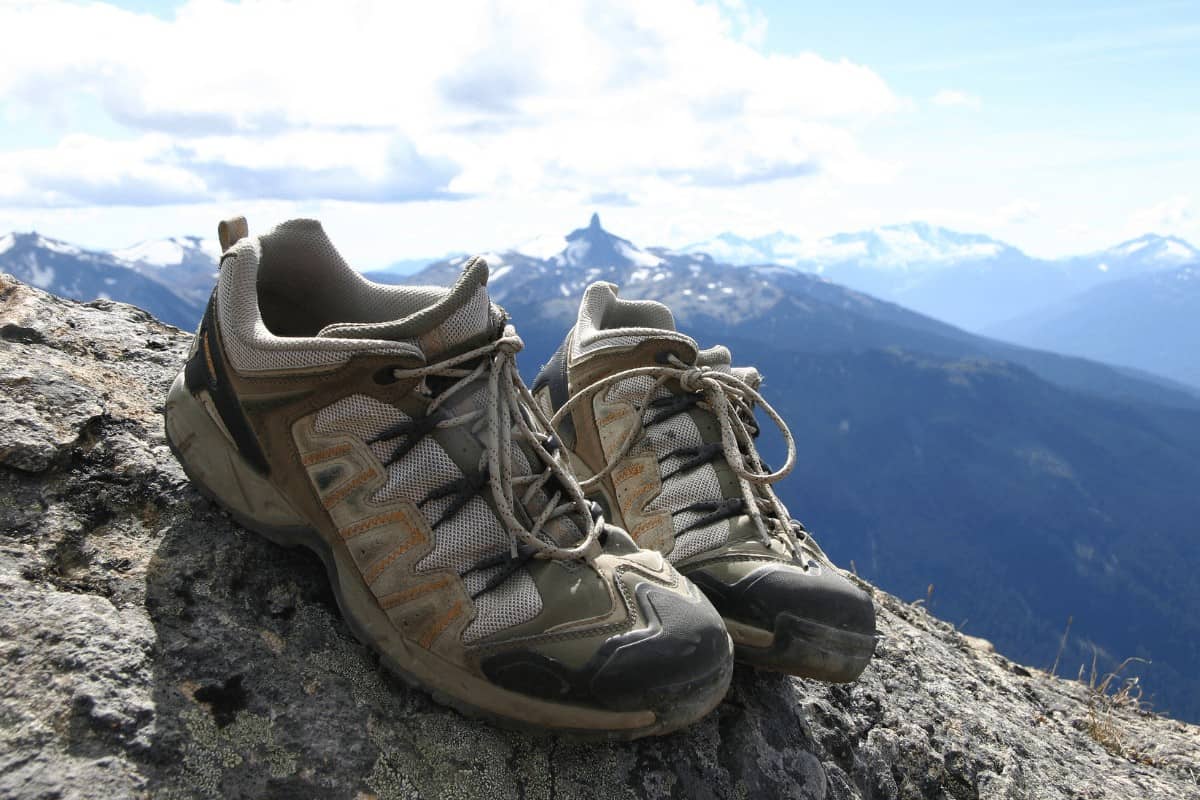Many experts and hikers suggest that a pair of hiking boots should be a half or full size larger than their normal shoe size or even the hiking boots that fit you perfectly.
Should Hiking boots be a bigger size than regular shoes? While some hikers may disagree on different styles and brands of your favorite hiker boots, even debates about the fabric, best insole, and also which lacing technique to use.
One thing all my fellow hikers all agree on is that the hiker boots or walking shoes should fit perfectly
However, it isn’t always easy to know what that perfect size may be. Everyone has had the experience of trying on a boot that feels perfectly comfortable in the store, only to have it be painful and create blisters later on the trail.

Do Hiking Boots Need to Be a Size Bigger?
Hiking boots almost always need to be larger than your normal shoe size. It’s always easier to put on an extra pair of socks, and take them off if needed than it is to overcome a hiking boot that is too small.
Can Hiking Boots Be Too Big?
Hiking boots provide support for the foot, but only if they fit correctly. Lace up the boots and make sure they’re snug around the ankles. If there’s too much room between the boot and the ankle, the hiking boots may be too big.
When buying hiking boots, have the foot department fit your shoe size correctly. Also always wear your hiking socks to correctly find your shoe size and fit.
Is It Better to Have Hiking Boots Too Big or Too Small?
If you can slide your foot from side to side inside the boot, then the boots are too wide and may cause blisters on the bottom and sides of your feet.
If their boots are snug, but not uncomfortably so, then you should be fine—most boots will stretch enough to ensure a comfortable fit.
Should My Hiking Boots Be Tight?
Hiking boots should fit snug everywhere, tight nowhere, and offer room to wiggle your toes. Try them on at the end of the day (after feet swell) and with the socks, you plan to wear.
Do Hiking Boots Stretch?
Hiking boots may stretch a little with wear, but this is more a case of them becoming snug, and fitting better, after you ‘break them in’ and not a case of the boots expanding to become too loose.
Stretching or easing may happen to your boots of natural materials. Also taking very good care of your boots will help you in the long run.
How Much Room Should Be in Boots?
You should be able to wiggle your toes inside the toe box (the front of the shoe). To see if you have enough room, slide your foot forward so your toes are just touching the end of the unlaced boot.
In this position, you should have a finger’s width (about ½”) between the base of your heel and the boot.
How Should Hiking Socks Fit?
If you are between sizes, size down to avoid excess material that can bunch up and cause blisters. How socks should fit: When you try socks on, look for a snug, but not overly tight fit.
A sock fits properly when the heel cup lines up with the heel of your foot. Also don’t cheap out on your socks, a really great pair of hiking socks will save your feet.
4 Reasons Why Hiking Boots Need to Be Larger than Regular Shoes
- Your feet get larger over the course of the day
- Your feet get larger when you are warm
- Your hiking footwear may not be the same as your regular footwear
- Descents are more difficult
How to Choose Your Perfect Hiking Boots
Choosing the right hiking boots is a matchmaking process. Your dream hiking boots need to sync with how and where you hike. Before you tie the knot, though, you also have to be sure they’re a perfect fit.
Types: You have a dizzying array of choices, from ultralight trail shoes to mountaineering boots.
Components: Understanding a little more about what goes into uppers, lowers, midsoles, outsoles and other parts of a boot can help you refine your selection.
Fit: No one ever loved a pair of ill-fitting boots. The difference between blisters and bliss is taking the time to get a great fit.
Check for The Length
First of all, check if the boots fit your feet in length. Most people have one foot longer than another, so you should check for the length of boots with your longer foot.
With the laces loosened up, put your longer foot into the hiking boot and stand up straight. Move your foot forward until your toes touch the end of the boot.
Then ask someone to check if there is room behind your heel. The room behind your heel should fit one finger if the boots are correctly fitted.
Your feet will swell after backpacking for a whole day, therefore, it is important there is room left in your boots.
Extra Tip: Another trick to ensure the hiking boots fit in length is by measuring the insoles. Take the insoles out of the boots and stand on them.
Check if there is space between your longest toe and the end of the insole. Space should be as wide as the thumb.
Lace up The Boots Correctly and Check the Width
It’s also important that your hiking boots also fit in width. If the boots are too wide to support your feet, you will get blisters on your feet; while if the width is too tight, the sides of your feet will be uncomfortably crunched during the whole trip.
To check if the boots fit in width, lace up your boots at first and then feel your feet in the boots. Make sure your feet are not squeezed inside and can’t slide from side to side.
It’s okay that the boots are a little snug since your hiking boots usually have about a 5 percent stretch.
Make Sure There Is No Heel Lift
Put on the hiking boots and walk on your toes to ensure there is a heel lift. And if when lacing your boots, leave the top of your feet loose and tighten up the area across your ankles to keep your heels secured.
It will give you blisters if your heel slips up and down when you are walking.
Put Your Hiking Socks on When Trying the Boots
When checking if your hiking boots fit, put on the hiking socks that you are going to wear for the trip. This can make sure that the boots fit most correctly.
Always Walk on An Inclined Surface
Since you have to walk up and down during hiking, you should try the boots on an inclined surface and see if they feel comfortable when climbing.
Also, spend 15 to 20 minutes walking around with the boots so that you can get used to the boots.
You Must Try the Boots at The End of The Day
Your feet are usually sweaty and swell a bit after a day’s walking. Trying the boots when your feet are a little swollen helps you to make the most correct decision.
Wear a Heavy Load ~ Take Your Backpack with You
When trying on new hiking boots to purchase, wear a heavy load to simulate the real-world situation in hiking. When you are hiking on the trail, the heavy backpack will add weight and your feet will shift a bit inside your shoes.
Therefore, you want to see if your feet feel comfortable in the boots when wearing your backpack
How Do You Break in Hiking Boots Faster?
Conclusion
Should hiking boots be a bigger size than regular shoes? Choosing the right hiking boots is a matchmaking process. Your dream hiking boots need to sync with how and where you hike.
Before you buy though, you also have to be sure they’re a perfect fit. Hopefully, these tips and tricks helped you find the perfect hiking boot.
Also, another great article that you may find insightful is on the REI website.
Articles from other authors
https://www.akasotech.com/blogs/how-to-check-if-hiking-boots-fit




